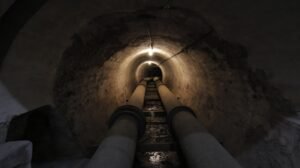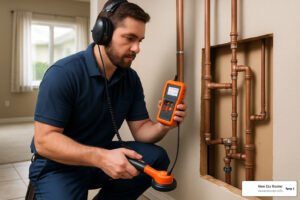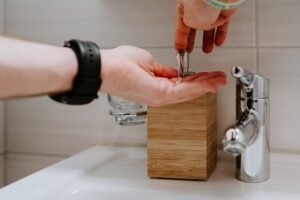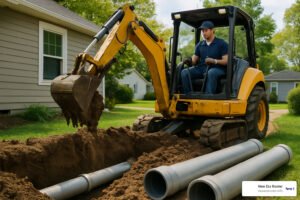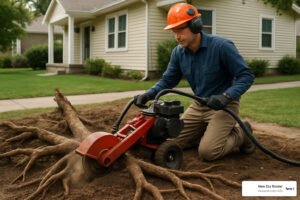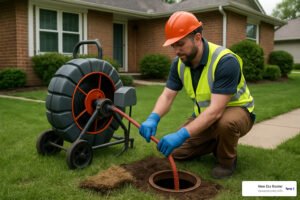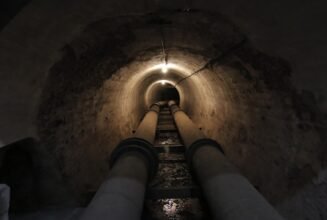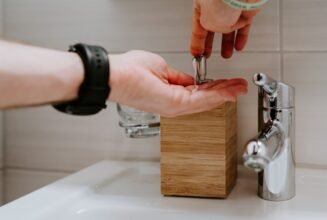Why Trenchless Plumbing is the Smart Choice for Modern Homeowners
Trenchless plumbing near me searches have skyrocketed as homeowners find they can fix broken sewer lines without destroying their landscapes. This no-dig technology saves time, money, and your beautiful yard.
Quick Answer for Trenchless Plumbing Near Me:
- Pipe Relining: $350-$400 per linear foot – inserts epoxy liner inside existing pipe
- Pipe Bursting: $400-$450 per linear foot – replaces entire pipe through small access holes
- Timeline: Most repairs completed in under one day vs. several days for traditional excavation
- Benefits: Preserves landscaping, 30-50% faster than open-cut methods, long-lasting results
Traditional sewer repair means weeks of disruption, destroyed driveways, and expensive landscaping restoration. Trenchless methods avoid large trenches and preserve landscaping, saving on finishing costs while delivering durable repairs that resist root intrusion.
Modern trenchless technology works on residential and commercial properties. Licensed contractors use specialized equipment to access your pipes through minimal entry points – typically just two small holes at each end of the damaged section.
The process is straightforward: technicians perform a camera inspection, create small access points, then either reline your existing pipe with epoxy resin or burst the old pipe while simultaneously pulling in a new one. Most trenchless repairs are completed in under a day, compared to the multi-day disruption of traditional excavation.
Customer satisfaction rates are exceptional, with many Ontario providers earning 4.9/5 star ratings from hundreds of users. The technology works on various pipe materials including cast iron, clay, and PVC, making it suitable for most residential plumbing situations.

Trenchless Plumbing Near Me: Methods, Costs & Timelines

When searching for “trenchless plumbing near me”, you’ll encounter several proven methods that accomplish repairs without extensive digging. Each technique serves specific situations and pipe conditions, offering homeowners alternatives to traditional excavation.
The three primary trenchless methods include pipe relining (also called CIPP – Cured-In-Place Pipe), pipe bursting, and supplementary services like hydro-jetting and CCTV inspection. Understanding these options helps you make informed decisions about your plumbing repairs.
| Method | Cost Range | Timeline | Best For |
|---|---|---|---|
| Pipe Relining | $350-$400/ft | 4-8 hours | Minor cracks, root intrusion |
| Pipe Bursting | $400-$450/ft | 6-12 hours | Severely damaged pipes |
| Traditional Excavation | $200-$300/ft + restoration | 3-5 days | Limited access situations |
How Trenchless Plumbing Near Me Works
The trenchless process begins with strategic entry holes – typically 3-4 feet wide at the beginning and end of the damaged pipe section. This minimal excavation contrasts sharply with traditional methods requiring continuous trenching along the entire pipe length.
For pipe relining, technicians insert a CIPP liner saturated with epoxy resin into the existing pipe. The liner inflates against the pipe walls, and the curing process creates a seamless, corrosion-resistant new pipe within the old one. This epoxy resin pipe relining creates a durable solution that can last 50+ years.
Pipe bursting uses a different approach. A hydraulic puller draws a bursting head through the old pipe, fracturing it while simultaneously pulling new pipe material behind it. The old pipe fragments remain in the ground, and the new pipe occupies the same space. Static bursting rigs can push rods up to 200 meters into old pipelines, making this method suitable for long pipe runs.
The curing process for relined pipes typically takes 2-4 hours, depending on pipe diameter and environmental conditions. During this time, the epoxy hardens into a smooth, jointless pipe that resists root intrusion and corrosion. Scientific research on cured-in-place pipe longevity demonstrates these repairs often outlast the original pipes.
Why Trenchless Beats Dig-and-Replace
Minimal excavation represents the most obvious advantage of trenchless methods. Traditional sewer replacement requires backhoes to dig continuous trenches, often 6-8 feet deep and 3-4 feet wide, along the entire pipe route. This destroys landscaping, damages hardscaping, and creates weeks of property disruption.
Faster completion times make trenchless repair attractive for busy homeowners and businesses. While traditional excavation projects stretch across multiple days or weeks, trenchless repairs typically finish within a single day. Rod string assembly and disassembly often take significantly less time than open-trench excavation.
Landscape-saving benefits extend beyond aesthetics. Preserving mature trees, established gardens, and expensive hardscaping saves thousands in restoration costs. We’ve seen homeowners avoid tearing up concrete driveways by choosing trenchless relining, eliminating both the demolition and replacement expenses.
Root resistance in new trenchless pipes prevents future problems. The seamless epoxy lining eliminates joints where roots typically infiltrate, while new pipe materials used in bursting resist root penetration better than older clay or cast iron pipes.
Environmental benefits include reduced soil disruption, lower carbon footprint from minimal equipment use, and prevention of groundwater contamination. Trenchless methods also generate less construction waste and require fewer restoration materials.
Trenchless Plumbing Near Me Cost Guide
Per-foot pricing varies based on pipe diameter, depth, soil conditions, and local market factors. In most markets, relining costs roughly $350-$370 per linear foot for 4-inch pipes, while pipe bursting runs $400-$450 per linear foot for similar dimensions.
Project length significantly impacts total costs. A typical residential sewer line repair covering 50-100 linear feet ranges from $17,500 to $45,000 for trenchless methods. While this seems expensive initially, traditional excavation plus landscaping restoration often costs more when factoring in surface repair expenses.
Permit fees add $200-$800 to most projects, depending on local regulations. Some municipalities offer expedited permitting for trenchless repairs due to reduced traffic and environmental impact.
Financing options help homeowners manage costs. Many contractors offer payment plans, and some utility companies provide rebates for trenchless repairs that reduce system infiltration. Insurance coverage varies, but many policies cover trenchless repairs when the damage results from covered perils.
Additional cost factors include:
- Access challenges (basement vs. yard access)
- Pipe depth and diameter
- Soil conditions and rock presence
- Required traffic control or permits
- Cleanup and minor restoration needs
Is Your Pipe a Candidate?
Cast iron pipes, common in homes built before 1980, often make excellent candidates for trenchless repair. These pipes typically suffer from corrosion and scale buildup rather than complete collapse, making relining an ideal solution.
Clay tile pipes present mixed candidacy. Well-aligned clay pipes with minor cracks work well for relining, while severely offset or collapsed sections may require pipe bursting or traditional replacement.
PVC pipes rarely need trenchless repair due to their durability, but when damage occurs (usually from ground shifting or tree roots), both relining and bursting work effectively.
Age-related cracks and minor separations respond well to relining. The epoxy liner bridges small gaps and reinforces weakened pipe walls, essentially creating a new pipe inside the old one.
Offset joints where pipe sections have separated require careful evaluation. Minor offsets (less than 1 inch) often work for relining, while severe misalignment may necessitate pipe bursting or traditional repair.
Tree root intrusion represents a common trenchless candidate. Hydro-jetting removes existing roots, and the seamless liner prevents future root penetration. However, active root pressure may require root cutting before relining.
Camera evidence provides definitive candidacy assessment. Professional CCTV inspection reveals pipe condition, identifies problem areas, and helps contractors recommend the most appropriate trenchless method.

Choosing a Local Trenchless Pro & Post-Repair Care

Finding the right contractor for trenchless plumbing near me searches isn’t as simple as picking the first name that pops up. This specialized work requires specific equipment, training, and experience that your average plumber might not have.
Think of it this way – you wouldn’t ask a general contractor to perform heart surgery, right? Trenchless repair is the “surgery” of the plumbing world. It needs someone who really knows what they’re doing.
Vetting contractors starts with checking their credentials. Make sure they hold proper plumbing licenses for your area and have specialized trenchless certifications. Many equipment manufacturers require specific training before contractors can use their systems – that’s a good sign when you find someone with these credentials.
Warranties tell you everything about a contractor’s confidence in their work. Professional companies offer warranties spanning 10-50 years on trenchless repairs. If someone won’t stand behind their work for at least a decade, keep looking.
Insurance claims can be tricky territory, but experienced contractors know how to help. They’ll provide detailed documentation and guide you through the process. Proper paperwork makes a huge difference in getting claims approved.
The best contractors don’t just fix your problem and disappear. They’ll give you maintenance tips and schedule follow-up inspections. This ongoing relationship shows they care about long-term results, not just quick profits.
How to Find & Compare Trenchless Contractors Near You
Start with the basics – license verification through your state’s contractor licensing board. Don’t skip this step. Also confirm they carry appropriate insurance coverage, including any special endorsements required for trenchless work.
When checking reviews, look for 4.9-star ratings from substantial numbers of customers rather than perfect scores from just a handful. Read what people say about specific trenchless methods and project outcomes. Generic “great service” reviews don’t tell you much about technical expertise.
Same-day quotes indicate a contractor with proper systems in place. Reputable trenchless companies can usually provide accurate estimates within 24-48 hours of your call. If they need weeks just to give you a quote, they might not be well-equipped for the job.
Emergency response capabilities matter, especially for urgent repairs. Companies offering 24/7 service typically maintain better equipment and staffing levels. When your sewer line fails at 2 AM on Sunday, you’ll appreciate having someone who actually answers the phone.
Here are the key questions to ask potential contractors: What specific trenchless methods do you offer? Can you provide references from recent projects? What warranty covers both materials and labor? Do you handle permits and inspections? What payment options are available? How do you handle unexpected complications during the job? Can you provide a detailed written estimate? What maintenance do you recommend after completion?
Maintenance, Warranty & Insurance FAQs
Annual camera checks help catch small issues before they become big problems. Many contractors offer discounted inspections for previous customers – it’s worth taking advantage of this preventive maintenance.
Clog prevention becomes much easier after trenchless repair because the new pipe interior is so smooth. Still, good habits matter. Avoid flushing anything that isn’t toilet paper, and keep grease out of your drains.
Warranty length varies significantly among contractors and methods. Pipe relining warranties typically run 10-50 years, while pipe bursting warranties often span 25-50 years. Look for transferable coverage if you might sell your home – it adds real value.
The warranty details matter more than just the length. Understand what’s covered (materials, labor, excavation costs) and what’s not (damage from new tree roots, ground shifting, or misuse). A 50-year warranty that excludes everything isn’t worth much.
Rebate eligibility exists in some areas for trenchless repairs that reduce water system infiltration. Contact your local water authority about potential rebates or financing programs. Every bit helps with these investment-level repairs.
Insurance coverage varies by policy and situation. Document everything thoroughly and understand what your policy covers for future issues. Some insurers actually prefer trenchless repairs because they’re more durable and less likely to cause repeat claims.
At New Era Rooter, we know that choosing trenchless solutions can feel overwhelming. That’s why we take time to explain your options clearly and provide honest recommendations based on your specific situation. Our 24/7 emergency response means you’re never stuck dealing with plumbing disasters alone.
We serve communities throughout Southern California, including Lake Elsinore, Temecula, San Diego, and surrounding areas. Our team brings decades of experience and state-of-the-art equipment to every job, whether it’s a routine inspection or complex trenchless installation.
Our skilled professionals handle everything from initial camera inspections to complete trenchless installations, backed by comprehensive warranties and transparent pricing. We believe in building long-term relationships with our customers, not just completing one-time jobs.
More info about sewer services — trust New Era Rooter for expert 24/7 trenchless solutions that preserve your property while delivering superior results. Contact us today to find how trenchless technology can solve your plumbing challenges without the disruption and expense of traditional excavation methods.



